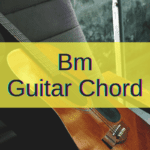If you have spent a lot of time playing other people’s songs you have probably noticed a lot of them tend to use the same groups of chords.
This is especially true of many songs that get a lot of radio or Spotify play because most people like songs that are somewhat familiar and easy to listen to… which are referred to as catchy tunes.
Just as notes have musical scales, there are accepted scales for chords too. From the chord that is central to a song (the key), these chords are given Roman numerals I – VII. The arrangement of these chords is referred to as the progression. You’ll see lots of I, IV, and V chords as they are very popular.
Many different cultures have their own musical tropes and use them over and over but today we will focus on music based in English language cultures.
And since we’re talking about guitar chord progressions, expect a lot of rock music too.
So if you’re trying to write a hit song, where should you begin?
What Are Chord Progressions?
Chord progressions are basically an accepted standard for what most people think sounds good.
Perhaps a music theorist would say that they are scientific or mathematical but I think they fall in the category of psychology.
More specifically the chords correspond to the notes in a musical scale and are often referred to by Roman numerals I – VII.
So for a C Major chord progression the chords are as follows: C Major, D Minor, E Minor, F Major, G Major, A Minor, and B Diminished.
You can have chord progressions based on minor scales too.
In most cases, you will encounter three or four chords played over four measures of the song.
Now, these are the proper chords in the progression if you’re playing full chords but we aren’t going to be too strict about the minor and diminished chords.
The reason for this is that the guitar part of many popular songs is played with power chords, also known as “5” chords.
Power chords consist of the root note twice and the 5th note in the scale sandwiched in between.
A minor chord means playing the root, a flat 3rd, and the 5th, so with a power chord, we don’t have the 3rd note to be able to flatten it.
Also, this list is far from exhaustive and will focus mostly on patterns (often in the verse) that I have noticed from songs that I have learned over the years.
So let’s check out some easy ways to get started writing songs…or conversely, some progressions to avoid if you want your music to sound fresh and unique.
4 Easy Chord Progressions for Guitar Used in Many Songs
1. I-V-VI-IV
When I think of the term “chord progression” this is one of the first that comes to my mind. It was part of many rock hits in the 1990s and has been used by more recent artists such as Taylor Swift, Rihanna, Pink, Lana Del Ray, Avicii, and more.
It’s easy to play and once you know what key the song is in, you’re ready to go, at least for that part of the song anyway. Here are some examples of this progression in use.
- When I Come Around by Green Day
- Let It Be by the Beatles
- Glycerine by Bush
- What’s My Age Again and Dammit by Blink-182
- Take On Me by A-ha
- No Woman, No Cry by Bob Marley
2. VI-IV-I-V
This one is similar to the previous one but puts the same chords in a different order. And practicing using arrangements that don’t start on the root chord (the key note of the song) is also useful.
Some absolutely massive hits used this progression.
- Hello by Adele (chorus)
- Faded and The Spectre by Alan Walker
- Numb by Linkin Park
- Self Esteem and The Kids Aren’t Alright by The Offspring
- One Of Us by Joan Osborne
- Otherside by Red Hot Chili Peppers
- Zombie by The Cranberries
3. I-IV-I-V
This is one that you will hear in a lot of songs and it often functions as the first part of longer chord progressions such as I-IV-I-V-I-IV-I. For example, in the key of C, you have C-F-C-G-C-F-C and for the key of A, it is A-D-A-E-A-D-A.
- Whenever You Come Around by Vince Gill
- Cotton Fields by Creedence Clearwater Revival (written by Huddie Ledbetter (Leadbelly)
- Simplified versions of Amazing Grace by John Newton
- Hound Dog by Elvis Presley (written by Jerry Leiber and Mike Stoller)
- Rock and Roll by Led Zeppelin
4. I-IV-V
Welcome to Punk 101. The use of I, IV, and V chords is prominent in Blues music but I-I-IV-V is the basis of perhaps the most famous punk rock song of all time: Blitzkrieg Bop, which used the chords A-D-E for the verse.
A lot of punk rock songs play the first chord for a while and then the last two chords of the progression in quick succession.
So I don’t think the chords in the progression are necessarily as important as the 3-chord style that grew out of it, because thousands of songs followed this trend. But I-IV-V does show up in some famous songs too.
- I Love Rock and Roll by Joan Jett & the Blackhearts (originally by the Arrows)
- Blitzkrieg Bop by the Ramones
- Good Riddance by Green Day (first half of the verse)
- Twist and Shout in the style of The Beatles (written by Phil Medley and Bert Berns)
Don’t get Stuck on Premade Chord Progressions
We have covered some very easy but also very popular chord progressions that will help you play many hit songs quickly.
But if you are interested in writing original material, I consider some of these to be pretty overused.
Although A-ha did have enough success to do the theme song for the James Bond film The Living Daylights, I think these days they are considered to be a one-hit wonder for Take On Me.
Joan Osborne and the performers of many other songs that I could have listed belong in this category too.
So don’t be afraid to change things up when you are composing.
Remember, Chord Progressions Can Be Used in Any Key
Luckily you can write a song in any key you want and you don’t have to worry about the chords in the progression no longer working where they’re supposed to.
That is why you can tune your guitar to a lower standard tuning with no problems but you could also play a song that uses A, D, and E chords with G, C, and D chords (without re-tuning).
Though admittedly some songs are simply easier to play with certain chords, which is probably why Paul McCartney tuned down a full step for Yesterday.
And if you use a lot of full chords instead of power chords, the chord progressions for minor keys also follow a pattern.
Here is the progression of A Minor: A Minor, B Diminished, C Major, D Minor, E Minor, F Major, and G Major.
Now if you can’t write a sad haunting song with those chords, you haven’t been paying attention.

Hello there, my name is Ramiro and I’ve been playing guitar for almost 20 years. I’m obsessed with everything gear-related and I thought it might be worth sharing it. From guitars, pedals, amps, and synths to studio gear and production tips, I hope you find what I post here useful, and I’ll try my best to keep it entertaining also.





